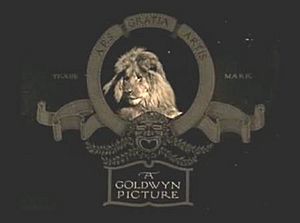Goldwyn Pictures facts for kids

Studio's 1917 opening logo, featuring a lion
|
|
| Industry | Film studio |
|---|---|
| Fate | Merged with Metro Pictures Corporation and Louis B. Mayer Pictures to form Metro-Goldwyn-Mayer |
| Successors | Studio: Metro-Goldwyn-Mayer Amazon MGM Studios Library: Warner Bros. (through Turner Entertainment Co.) Public domain |
| Founded | November 19, 1916 |
| Founders | Samuel Goldwyn Edgar Selwyn Archibald Selwyn |
| Defunct | April 17, 1924 |
| Headquarters |
,
U.S.
|
| Products | Movies |
Goldwyn Pictures Corporation was an American movie company. It made films from 1916 to 1924. In 1924, it joined with two other companies. This created the famous studio, Metro-Goldwyn-Mayer (MGM).
The company was started on November 19, 1916. Its founders were Samuel Goldfish (who later changed his name to Goldwyn). He was a leader at another film company. He teamed up with Broadway producer brothers Edgar and Archibald Selwyn. They combined parts of their names to create "Goldwyn."
Goldwyn Pictures was quite successful. It became very well-known for its famous Leo the Lion logo. Even though Metro Pictures was the main company in the merger, the new MGM studio kept Goldwyn's old building. This building was in Culver City, California. MGM used this studio until 1986. The new studio also kept Goldwyn's lion logo. Lee Shubert, a theater owner, also invested in the company.
Contents
The Story of Goldwyn Pictures
How the Company Started
Samuel Goldfish left his old company in 1916. He had helped start Lasky's Feature Play Company. But it merged with another company. So, he decided to start his own. He joined with Edgar and Archibald Selwyn. Edgar's wife, Margaret Mayo, was a writer. She also joined the team. Arthur Hopkins, another Broadway producer, also came on board.
At first, Goldwyn Pictures rented space in Fort Lee, New Jersey. Many early movie studios were located there. The company's first movie was Polly of the Circus. It was based on a play by Margaret Mayo. The film came out in September 1917. It starred Mae Marsh.
By April 1917, Goldwyn Pictures rented studios from Universal Pictures in Fort Lee. They had big plans for making many movies. The company also worked with Columbia University. They wanted to make their films more artistic. They even released movies from other small production companies.
Challenges and Changes
In October 1917, the company faced a problem. Censors in Pennsylvania and Chicago did not approve one of their films. So, they had to switch it out for another movie. Another film, Thais, lost a lot of money.
In January 1918, Samuel Goldfish tried to sign director Raoul Walsh. But Walsh was still under contract with another company. After Thais lost money, Goldfish decided to spend less on films. He stopped using expensive theater stars. Instead, he focused on comedies. These movies starred actors like Madge Kennedy and Mabel Normand.
In August 1918, Goldwyn Pictures signed Will Rogers. He was a popular Broadway star. He made a movie called Laughing Bill Hyde. The company also bought the Triangle Studios in Culver City in 1918. Goldfish then moved west to Culver City, California. This move also made film costs go up. In December, Samuel Goldfish officially changed his name to Samuel Goldwyn.
Growth and Mergers
In 1919, Frank Joseph "Joe" Godsol invested in Goldwyn Pictures. He had experience making deals for theater companies.
Goldwyn wanted to own movie theaters, too. This is called "vertical integration." It means owning all parts of the business, from making movies to showing them. Goldwyn and his supporters wanted to rent the Astor Theatre. But instead, they bought a big share in the Capitol Theatre in May 1920. However, the investors wanted the theater to show movies from many companies, not just Goldwyn's.
By 1920, Goldwyn Pictures owned its studio in Culver City. It also rented two studios in New York and kept operations in Fort Lee.
The End of Goldwyn Pictures
After some disagreements, Samuel Goldwyn left the company in 1922. Joe Godsol became the new head of Goldwyn Pictures. In 1923, Lee Shubert talked to Marcus Loew about merging Goldwyn Pictures with Loew's Metro Pictures. Loew agreed to the merger.
Louis B. Mayer heard about this plan. He then suggested adding his own company, Louis B. Mayer Productions, to the merger. This led to the creation of the huge studio, Metro-Goldwyn-Mayer.
Talented People at Goldwyn Pictures
Goldwyn Pictures worked with many talented actors and directors.
Actors
- Mae Marsh
- Mabel Normand
- Pauline Frederick
- Madge Kennedy
- Tallulah Bankhead
- Will Rogers
- E.K. Lincoln
Directors
- Raoul Walsh
- Ralph Ince
- Frank Lloyd
- Sidney Olcott
Film Legacy
Many of Goldwyn Pictures' early films are now lost. A big fire in an MGM storage building in 1965 destroyed many old movie copies. This included most of Goldwyn's films made before 1924.
Later, in 1986, Ted Turner bought all the MGM films made before May 1986. This included the movies from Goldwyn Pictures.
See also
- Samuel Goldwyn Productions, Samuel Goldwyn's next production company
- Samuel Goldwyn Studio, informal name for the Pickford-Fairbanks Studios lot in Hollywood.
- The Samuel Goldwyn Company, founded by Samuel Goldwyn Jr. in 1979, active through 1997
- Samuel Goldwyn Films, founded by Samuel Goldwyn Jr.

